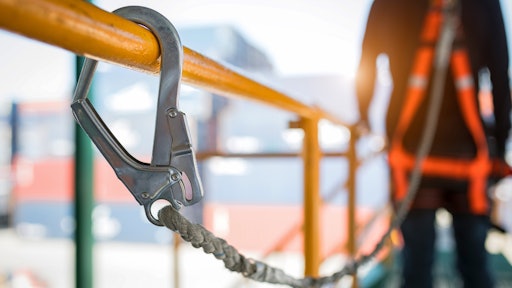Table of Contents

Employers must provide their employees with the proper equipment and fall prevention measures in order to avoid fall-related injuries.
@Aunging – adobe.stock.com
With cooler temperatures comes earlier sunsets, and an array of stunning colors across the country. However, it’s also the beginning of various new challenges for businesses. Fall brings on cold and flu season and daylight savings time that can have an impact on workers’ health. Additionally, autumn weather often leads to slippery roads, walkways and sidewalks to due to the rainy, chilly weather or wet, fallen leaves.
Worker safety should be in mind throughout the entire year for business owners, and the fall is no different. And, what is one of the leading causes of death for employees, especially those in the construction industry? Falls.
According to the U.S. Bureau of Labor Statistics, in 2021 over one-third of construction fatalities were due to falls, slips and trips. Almost all of these were falls from heights to a lower level.
What is Fall Protection?
Fall protection refers to any means used to protect workers from falls during work where such hazards exist. This includes areas like stairways, raised platforms, roofs and the use of ladders in general. In these areas, engineering or design measures are used to help reduce the fall hazards; however, further measures such as fall protection devices like lanyards, harnesses and guardrails must be used to help reduce the risk of falls.
OSHA created Construction Standards for Fall Protection, which states that employers must provide fall protection if employees are required to work in the situations and conditions outlined in the standards, including those who work on scaffolds, cranes and derricks, perform steel erection work, and those who work from aerial lifts, poles, towers, ladders, and stairways.
Preventing falls in the workplace often begins with having a plan – a set of written procedures. Your plan should clearly lay out procedures for items such as fall prevention training, safe equipment use and inspection of the worksite for any potential hazards.
Make sure your fall protection plan is an essential component of your workplace safety program. Many successful programs contain the following elements:
-
Education of employees through training programs that focus on fall protection practices
- Business owners and management show they are committed to workplace safety as they are to other aspects of the business
-
Regular inspection of the fall protection equipment, replacing worn or broken equipment as needed
-
Employers must provide their employees with the proper equipment and fall prevention measures in order to avoid fall-related injuries. This might include items such as:
- Evaluate your plan regularly to identify how well it’s performing and if any updates are needed
Fall Prevention Strategies for the Workplace
Employers must provide their employees with the proper equipment and fall prevention measures in order to avoid fall-related injuries. This might include items such as:
- Body harnesses: Straps that may be secured about the employee in a manner that will distribute the fall arrest forces over at least the thighs, pelvis, waist, chest and shoulders with means for attaching it to other components of a personal fall arrest system.
- Guardrail systems: A top rail 42 plus or minus 3 inches high, a toeboard 4 inches high, and a midrail located between the top rail and toeboard. A guardrail system is capable of withstanding a force of 200 pounds in any outward or downward direction on the toprail and a force of 150 pounds in any outward or downward direction on the midrail without failure.
- Personal fall arrest systems: A system used to arrest an employee in a fall from a working level. It consists of an anchorage, connectors, a body harness, and may include a lanyard, deceleration device, lifeline or suitable combinations of these. All lanyards and other fall arrest devices have locking snap hooks.
- Safety net systems: A net that is installed as close as practicable under the walking/working surface on which employees are working, but not more than 30 feet below such surface.
- Lanyards/Lifelines: A flexible line of rope, wire rope or strap that generally has a connector at each end for connecting the body belt or body harness to a deceleration device, lifeline or anchorage.
